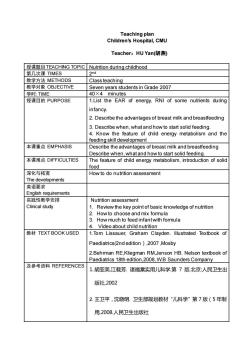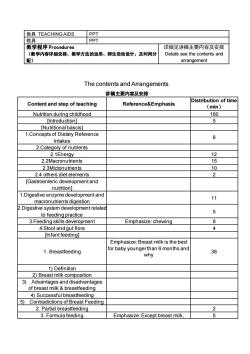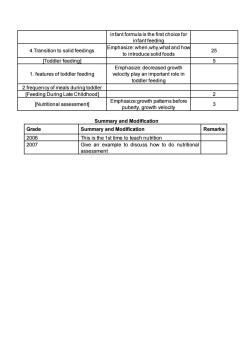《儿科学》课程教学资源(授课教案)03 Nutrition During Childhood

Teaching planChildren's Hospital, CMUTeacher:HUYan(胡燕)授课题目TEACHINGTOPICNutritionduringchildhood第几次课TIMES2nd教学方法METHODSClass teaching教学对象OBJECTIVESeven years students in Grade 200740×4minutes学时:TIME授课目的PURPOSE1.List the EAR of energy, RNI of some nutrients duringinfancy.2.Describe the advantages of breast milk and breasfeeding3. Describe when, what and how to start solid feeding.4. Know the feature of child energy metabolism and thefeeding skill development本课重点EMPHASISDescribe theadvantages of breast milk andbreastfeedingDescribe when, what and how to start solid feeding.本课难点DIFFICULTIESThe feature of child energy metabolism, introduction of solidfood深化与拓宽How to do nutrition assessmentThe developments英语要求English requirementsNutrtion assessment实践性教学安排Clinical study1. Review the key point of basic knowledge of nutrition2. How to choose and mix formula3. How much to feed infantwith formula1Videoaboutchildnutrition教材TEXTBOOKUSED1.Tom Lissauer, Graham Clayden. Ilustrated Textbook ofPaediatrics(2nd edition ) ,2007 ,Mosby2.Behrman RE,Kliegman RM,Jenson HB. Nelson textbook ofPaediatrics 18th edition2008.WB Saunders Compan及参考资料 REFERENCES1.胡亚美,江载芳.诸福棠实用儿科学.第7版.北京:人民卫生出版社,2002王卫平,沈晓明卫生部规划教材“儿科学”第7版(5年制用,2008.人民卫生出版社
Teaching plan Children’s Hospital, CMU Teacher:HU Yan(胡燕) 授课题目TEACHING TOPIC Nutrition during childhood 第几次课 TIMES 2 nd 教学方法 METHODS Class teaching 教学对象 OBJECTIVE Seven years students in Grade 2007 学时: TIME 40×4 minutes 授课目的 PURPOSE 1.List the EAR of energy, RNI of some nutrients during infancy. 2. Describe the advantages of breast milk and breastfeeding 3. Describe when, what and how to start solid feeding. 4. Know the feature of child energy metabolism and the feeding skill development 本课重点 EMPHASIS Describe the advantages of breast milk and breastfeeding Describe when, what and how to start solid feeding. 本课难点 DIFFICULTIES The feature of child energy metabolism, introduction of solid food 深化与拓宽 The developments How to do nutrition assessment 英语要求 English requirements 实践性教学安排 Clinical study Nutrition assessment 1. Review the key point of basic knowledge of nutrition 2. How to choose and mix formula 3. How much to feed infant with formula 4. Video about child nutrition 教材 TEXT BOOK USED 1.Tom Lissauer, Graham Clayden. Illustrated Textbook of Paediatrics(2nd edition),2007 ,Mosby 2.Behrman RE,Kliegman RM,Jenson HB. Nelson textbook of Paediatrics 18th edition,2008, W.B Saunders Company 及参考资料 REFERENCES 1. 胡亚美,江载芳. 诸福棠实用儿科学.第 7 版.北京:人民卫生出 版社,2002 2. 王卫平,沈晓明. 卫生部规划教材“儿科学”第 7 版(5 年制 用,2008.人民卫生出版社

教具 TEACHINGAIDS[PPT教具PPT教学程序Procedures详细见讲稿主要内容及安排(教学内容详细安排、教学方法的运用、师生活动设计、及时间分Details see the contents and配)arrangement The contents and Arrangements讲稿主要内容及安排Distribution of timeContent and step of teachingReference&Emphasis(min)Nutrition during childhood160[Introduction]5[Nutritionalbascis]1.Concepts of Dietary Reference8Intakes2.Category of nutrients122.1Energy2.2Macronutrients15%2.3Mictonutrients2.4 others diet elements2Gastroentericdevelopmentandnutrition]1.Digestive enzyme developmentand11macronutrientsdigestion2.Digestive system development related5to feeding practice3.Feeding skills developmentEmphasize: chewing84.Stool and gut flora?[Infantfeeding]Emphasize: Breast milk is the bestfor baby younger than 6 months and381. Breastfeedingwhy1)Definition2)Breastmilkcomposition3) Advantages and disadvantages of breast milk & breastfeeding4)Successfulbreastfeeding5)Contradictions of Breast Feeding2. Partial breastfeeding2 3. Formula feedingEmphasize: Except breast milk,5
教具 TEACHING AIDS PPT 教具 PPT 教学程序 Procedures (教学内容详细安排、教学方法的运用、师生活动设计、及时间分 配) 详细见讲稿主要内容及安排 Details see the contents and arrangement The contents and Arrangements 讲稿主要内容及安排 Content and step of teaching Reference&Emphasis Distribution of time (min) Nutrition during childhood 160 [Introduction] 5 [Nutritional bascis] 1.Concepts of Dietary Reference Intakes 8 2.Category of nutrients 2.1Energy 12 2.2Macronutrients 15 2.3Mictonutrients 10 2.4 others diet elements 2 [Gastroenteric development and nutrition] 1.Digestive enzyme development and macronutrients digestion 11 2.Digestive system development related to feeding practice 5 3.Feeding skills development Emphasize: chewing 8 4.Stool and gut flora 4 [Infant feeding] 1. Breastfeeding Emphasize: Breast milk is the best for baby younger than 6 months and why 38 1) Definition 2) Breast milk composition 3) Advantages and disadvantages of breast milk & breastfeeding 4) Successful breastfeeding 5) Contradictions of Breast Feeding 2. Partial breastfeeding 2 3. Formula feeding Emphasize: Except breast milk, 5

infantformulaisthefirstchoiceforinfant feedingEmphasize:when,why.whatandhow254.Transition to solid feedingsto introduce solid foods[Toddlerfeeding]5Emphasize:decreased growth1. features of toddler feedingvelocity play an importantrole intoddler feeding2.frequency of meals during toddler[Feeding During Late Childhood]2Emphasize:growthpattemsbefore[Nutitional assessment]3puberty, growth velocitySummaryandModificationGradeSummary and ModificationRemarks2006This is the 1st time to teach nutrition2007Give an example to discuss how to do nutritionalassessment
infant formula is the first choice for infant feeding 4.Transition to solid feedings Emphasize: when,why,what and how to introduce solid foods 25 [Toddler feeding] 5 1. features of toddler feeding Emphasize: decreased growth velocity play an important role in toddler feeding 2.frequency of meals during toddler [Feeding During Late Childhood] 2 [Nutritional assessment] Emphasize:growth patterns before puberty, growth velocity 3 Summary and Modification Grade Summary and Modification Remarks 2006 This is the 1st time to teach nutrition 2007 Give an example to discuss how to do nutritional assessment
按次数下载不扣除下载券;
注册用户24小时内重复下载只扣除一次;
顺序:VIP每日次数-->可用次数-->下载券;
- 《儿科学》课程教学资源(授课教案)09 Haematopoiesis and Blood Cell Counts.doc
- 《儿科学》课程教学资源(授课教案)08 Congenital Heart Disease.doc
- 《儿科学》课程教学资源(授课教案)06 Hypoxic-ischemic Encephalopathy.doc
- 《儿科学》课程教学资源(授课教案)07 Bronchopneumonia.doc
- 《儿科学》课程教学大纲 Teaching Outline for Pediatrics Course(英文).pdf
- 《临床生物化学》课程教学资源(PPT课件)第十九章 自动临床生物化学分析仪的应用及评价.ppt
- 《临床生物化学》课程教学资源(PPT课件)第十八章 治疗药物浓度监测.ppt
- 《临床生物化学》课程教学资源(PPT课件)第十七章 妊娠的生物化学检验.ppt
- 《临床生物化学》课程教学资源(PPT课件)第十六章 肿瘤标志物的生物化学检验.ppt
- 《临床生物化学》课程教学资源(PPT课件)第十五章 神经系统疾病的生物化学检验.ppt
- 《临床生物化学》课程教学资源(PPT课件)第十四章 消化系统疾病的生物化学检验.ppt
- 《临床生物化学》课程教学资源(PPT课件)第十三章 内分泌疾病的生物化学检测.ppt
- 《临床生物化学》课程教学资源(PPT课件)第十二章 心血管系统疾病的生物化学检测.ppt
- 《临床生物化学》课程教学资源(PPT课件)第十一章 肾功能损伤的生物化学检验.ppt
- 《临床生物化学》课程教学资源(PPT课件)第十章 肝胆疾病的生物化学检验.ppt
- 《临床生物化学》课程教学资源(PPT课件)第九章 营养状况的评估及的生物化学监测.ppt
- 《临床生物化学》课程教学资源(PPT课件)第八章 微量元素与维生素异常的生物化学检验.ppt
- 《临床生物化学》课程教学资源(PPT课件)第七章 骨代谢紊乱及相关元素的生物化学检验.ppt
- 《临床生物化学》课程教学资源(PPT课件)第六章 电解质和酸碱平衡紊乱的生物化学检验.ppt
- 《临床生物化学》课程教学资源(PPT课件)第五章 血浆脂蛋白代谢紊乱的生物化学检验.ppt
- 《儿科学》课程教学资源(授课教案)02 Growth and Development.doc
- 《儿科学》课程教学资源(授课教案)05 Neonatal Septicemia.doc
- 《儿科学》课程教学资源(授课教案)04 Neonatal Jaundice.doc
- 《儿科学》课程教学资源(授课教案)01 Introduction of Pediatrics.doc
- 《儿科学》课程教学资源(授课教案)25 Scarlet Fever.doc
- 《儿科学》课程教学资源(授课教案)23 Infantile Hepatitis Syndrome.doc
- 《儿科学》课程教学资源(授课教案)22 Infantale Diarrhea and Fluid Therapy.doc
- 《儿科学》课程教学资源(授课教案)24 Mumps.doc
- 《儿科学》课程教学资源(授课教案)18 Primary Pulmonary Tuberculosis.doc
- 《儿科学》课程教学资源(授课教案)21 Chronic Gastritis in Children.doc
- 《儿科学》课程教学资源(授课教案)20 Toxic Bacillary Dysentery.doc
- 《儿科学》课程教学资源(授课教案)19 Tuberculosis Meningitis.doc
- 《儿科学》课程教学资源(授课教案)16 Measles.doc
- 《儿科学》课程教学资源(授课教案)17 Varicella.doc
- 《儿科学》课程教学资源(授课教案)14 Congenital Hypothyroidism.doc
- 《儿科学》课程教学资源(授课教案)15 Growth Hormone Deficiency.doc
- 《儿科学》课程教学资源(授课教案)10 Nutritional Iron Deficiency Anemia.doc
- 《儿科学》课程教学资源(授课教案)13 Immunodeficiency.doc
- 《儿科学》课程教学资源(授课教案)11 Acute Convulsion in Children.doc
- 《儿科学》课程教学资源(授课教案)12 Acute Glomerulonephritis,Nephrotic Syndrome.doc
